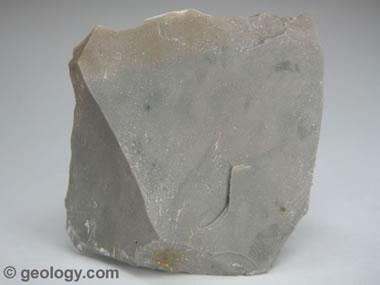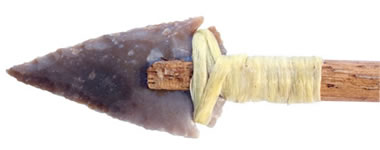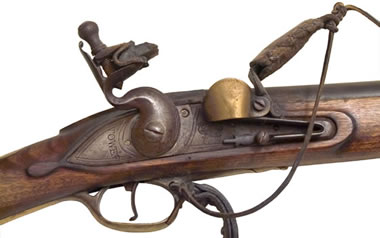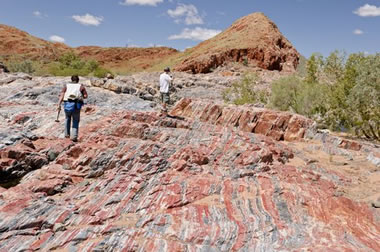What is Chert?
Chert is a microcrystalline or cryptocrystalline sedimentary rockmaterial composed of silicon dioxide (SiO2). It occurs as nodules, concretionary masses and as layered deposits. Chert breaks with a conchoidal fracture, often producing very sharp edges. Early people took advantage of how chert breaks and used it to fashion cutting tools and weapons. The name "flint" is also used for this material.
How Does Chert Form?
 |
| Diatoms are microscopic, single-celled algae that live in marine or fresh water. They produce hard parts made of silicon dioxide. NASA Image. | | | Chert can form when microcrystals of silicon dioxide grow within soft sediments that will become limestoneor chalk. In these sediments, enormous numbers of silicon dioxide microcrystals grow into irregularly-shaped nodules or concretions as dissolved silica is transported to the formation site by the movement of ground water. If the nodules or concretions are numerous they can enlarge and merge with one another to form a nearly continuous layer of chert within the sediment mass. Chert formed in this manner is a chemical sedimentary rock.
Some of the silicon dioxide in chert is thought to have a biological origin. In some oceans and shallow seas large numbers of diatoms and radiolarians live in the water. These organisms have a glassy silica skeleton. Some sponges also produce "spicules" that are composed of silica. When these organisms die their silica skeletons fall to the bottom, dissolve, recrystallize and might become part of a chert nodule or chert layer. Chert formed in this way could be considered a biological sedimentary rock.
What is Chert's Composition?
Chert is a microcrystalline silicon dioxide (SiO2). As chert nodules or concretions grow within a sediment mass their growth can incorporate significant amounts of the surrounding sediment as inclusions. These inclusions can impart a distinctive color to the chert.
What Color is Chert?
Chert occurs in a wide variety of colors. Continuous color gradients exist between white and black or between cream and brown. Green, yellow and red cherts are also common. The darker colors can result from inclusions of sediment or organic matter. The name "flint" is often used in reference to the darker colors of chert. Red to reddish-brown cherts receive their color from included iron oxide. The name "jasper" is frequently used for these reddish cherts.
What are the Uses of Chert?
Chert has very few uses today; however, it was a very important tool-making material in the past. Chert has two properties that made it especially useful: 1) it breaks with a conchoidal fracture to form very sharp edges, and, 2) it is very hard (7 on the Mohs Scale). The edges of broken chert are sharp and tend to retain their sharpness because chert is a very hard and very durable rock. Thousands of years ago people discovered these properties of chert and learned how to intentionally break it to produce cutting tools such as knife blades, arrowheads, scrapers, and ax heads. Tons of chert fragments have been found at locations where these objects were produced in what was one of the earliest manufacturing activities of people.
 |
| Occastionally, specimens of chert with attractive colors or interesting patterns are cut as gemstone. This chert cabochon is an example. | | | Chert is not found everywhere. It was a precious commodity that early people traded and transported long distances. As early as 8000 BC the people of what are now England and France dug shafts up to 300 feet deep into layers of soft chalk to mine chert nodules. These are some of the oldest mining operations ever discovered.
Chert is a very hard material that produces a spark when it is struck against steel. The heat from this spark can be used to start fires. A "flint lock" is an early firearm in which a charge of gunpowder is ignited by a flint hammer striking a metal plate (see image at right).
A variety of metamorposed chert, known as "novaculite", has a porous, even texture that makes it useful as a sharpening stone. The Arkansas Novaculite Formation has become world famous as a source of high quality sharpening stones and novaculite abrasive products.
Contributor: Hobart King
 |
 |

| Chert: This specimen of chert is about two inches (five centimeters) across. It displays conchoidal fracture and has broken to produce sharp edges. |

| Chert Arrowhead: A chert (flint) arrowhead bound to a wooden arrow shaft with sinew. Image copyright by iStockPhoto and Brian Brockman. |

| Flintlock: A close-up of the lock of a flintlock rifle, a weapon of the 18th century used in the Revolutionary War. Note the piece of chert (flint) in the hammer. Image copyright by iStockPhoto and Kakupacal. |

| Outcrop of the 3.4 Ga Marble Bar Chert, Pilbara Craton, Australia. The hematite-rich chert has been used as evidence of high levels of atmospheric oxygen in the early Archean. Image by NASA Astrobiological Institute. |
|